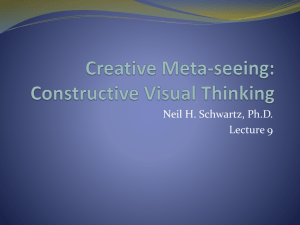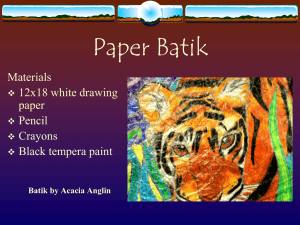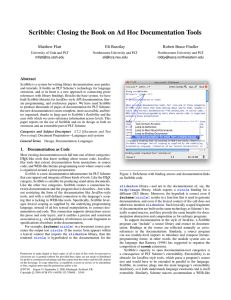Integrating Art Therapy into School-Aged Programming
advertisement
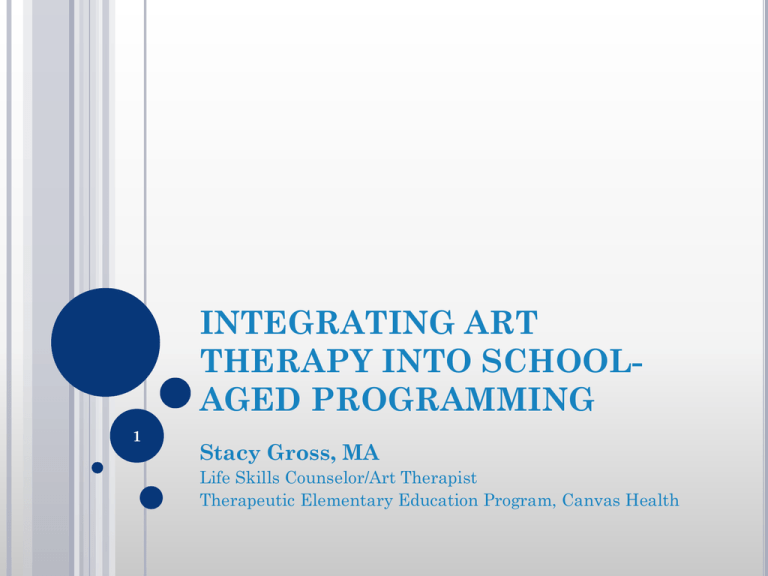
INTEGRATING ART THERAPY INTO SCHOOLAGED PROGRAMMING 1 Stacy Gross, MA Life Skills Counselor/Art Therapist Therapeutic Elementary Education Program, Canvas Health ART MAKING EXPERIENTIAL Take about 10 minutes to draw what the caveman is running from… If you don’t have a pen, I have some pencils… We’ll come back to this later… 2 WHAT IS ART THERAPY? As defined by the American Art Therapy Association (2011), “Art therapy is the therapeutic use of art making, within a professional relationship, by people who experience illness, trauma, or challenges in living, and by people who seek personal development. Through creating art and reflecting on the art products and processes, people can increase awareness of self and others; cope with symptoms, stress, and traumatic experiences; enhance cognitive abilities; and enjoy the life-affirming pleasures of making art.” 3 ART THERAPY CONTINUED… Art therapy is an effective treatment for people experiencing developmental, medical, educational, and social or psychological impairment. Art therapists work in a wide variety of settings including hospitals, psychiatric and rehabilitation facilities, wellness centers, forensic institutions, schools, crisis centers, senior communities, private practice, and other clinical and community settings Art therapists are trained in both art-making and counseling 4 WHAT DOES AN ART THERAPIST DO? I encourage clients to create art and reflect on their art I help clients learn and use artistic media to express themselves I teach clients how to use art as an emotional container 5 ART THERAPY CAN… Change attitudes Increase assertiveness Impact self-development Expand children’s awareness Stimulate verbal and nonverbal communication Provide insights Release and relieve emotional stress Develop coping strategies 6 SKILLS CHILDREN LEARN FROM ART Creativity Confidence Problem Solving Perseverance Focus Non-verbal Communication Collaboration Dedication 7 STAGES OF GRAPHIC DEVELOPMENT The Scribble Stage (10 months-4 years) Random Scribble Stage (10 months-2 years) Longitudinal Scribble Stage (2-3 years) Concentric Scribble Stage (2-3 ½ years) Isolated Closure Stage (3-4 years) Preschematic Stage (4-7 years) Schematic Stage (7-9 years) Realistic Stage (9-11 years) Naturalistic Stage (12-14 years) 8 SCRIBBLE STAGE (10 MONTHS-4 YEARS) * Color use is random during this stage Random Scribble Stage (10 months-2 years) Longitudinal Scribble Stage (2-3 years) Characterized by concentric circles Between ages of 3 and 4 years, scribble changes from counterclockwise to clockwise Isolated Closure Stage (3-4 years) Repetition of movement; learning takes place Develop an awareness of boundaries of paper Concentric Scribble Stage (2-3 ½ years) Based on normal development of reaching, grasping, clasping Tools are an extension of the hand Characterized by closure of figures and spontaneous naming of figures Has ability to create boundaries and purposeful form Appropriate Art Materials: Large crayons Washable markers Chalk on chalkboard Thick tempera paint with ¾” brushes Flat surfaces to work on 9 PRE-SCHEMATIC STAGE (4-7 YEARS) Encephalopod—typical 4 year old form Beginning to develop graphic capability as shown in form Appropriate art materials: Tempera paint on large paper Crayons on smaller paper Pencils for more detail Thick markers to increase control Towards the end of the stage, skinny markers Avoid constant variation of materials 10 SCHEMATIC STAGE (7-9 YEARS) Schema—consistent graphic representation Schematic deviations occur when something is either significant or unimportant Most people stop developing their ability to draw sometime between the ages of 7 and 9 years Appropriate art materials: Facilitate self expression, not inhibit it Don’t force materials Thick tempera paints Large paper Crayons Chalk Collage Natural items 11 REALISTIC STAGE (9-11 YEARS)* *NOT EVERYONE GETS TO THIS STAGE Schema is no longer adequate—humans are differentiated, usually by clothing Trying hard to get things right “Gang” stage—when gang is left out, think about social isolation In this stage of development (graphic and otherwise), drawings can be used to increase a different point of view 12 MEDIA (AFFECTIVE) (COGNITIVE) Watercolor on wet paper Stone/Wood Sculpture Fingerpaint on fingerpaint paper Clay Other paints on dry paper Colored pencils/pencils Collage Chalk pastels Crayons Oil pastels Soft water-based clay Markers 13 INTEGRATING ART THERAPY INTO PROGRAM The process of creating art is just as, if not more, important than the product Strategically placed/utilized interventions can help reduce anxiety, promote relaxation, and foster the development of coping skills 14 MANDALAS Clinically proven to reduce stress and induce relaxation Utilize a combination of coloring sheets and blank circles Ideas for integration: MCA testing After gym 15 DOODLE BOOKS Foster creativity while reducing anxiety Ideas for integration: Art projects Supplement to coloring sheets The Boys’ Doodle Book: Amazing Pictures to Complete and Create by Andrew Pinder The Anti-Coloring Book by Susan Striker 16 ZENTANGLE Drawing structured patterns Relaxing Increases focus There’s no wrong way to do it so everyone is “good” at it Ideas for integration: Art project Quiet activity/fidget 17 PLAY-DOH BOARDS Sensory integration technique Can be used to reduce anxiety and assist in the development of a feeling of calm May be useful when talking with a student when they are in “trouble” SCRATCH Very kinesthetic Tool that can benefit those feeling anxious You can purchased packaged scratch boards or students can make their own 18 CREATING A WINDOW Cut out a small window in construction paper Place this on top of the paper where the child is drawing The child draws on the paper through the image Fosters containment and reduces anxiety 19 HOW TO TALK TO CHILDREN ABOUT ART Let children create their own art without making uninvited marks on it Take time to reflect on the art Approach the image with curiosity (the child is the artist and the expert on the meaning) Be mindful of your speech Treat the completed work with respect and care Using our caveman drawing from earlier, what are some things you might say? 20 HELPFUL PICTURE BOOKS Ish by Peter K. Reynolds The Dot by Peter K. Reynolds Beautiful Oops by Barney Saltzberg My Many Colored Days by Dr. Suess One by Kathryn Otoshi 21 THINGS TO REMEMBER You are NOT an art therapist Art making is a legitimate, evidence-based practice and clinical treatment Some believe that you should always make art when the children are while some believe that it could inadvertently influence them; use your judgment What you are already doing with children is a form of therapeutic art 22 HOW TO CREATE AN ART DIRECTIVE (USING A PICTURE BOOK) Once you’ve picked out a book, think about… What do you want each child to learn from the book? Were there any artistic elements that you can piggyback off of? How could the children best experience the lesson from the book? Remember… There is no wrong way to do this; try and if it doesn’t work out, adjust it for next time Use your resources! 23 Thank you! Questions or comments? Stacy Gross, MA stacyleegross@gmail.com 24
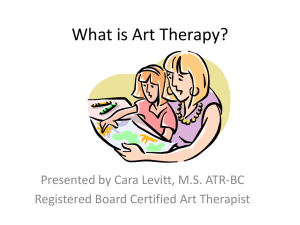
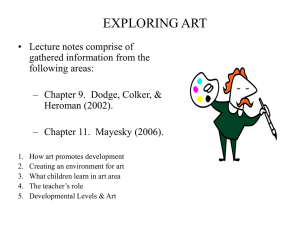
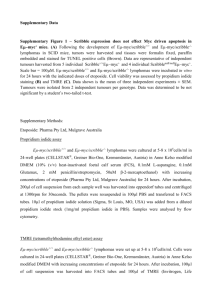
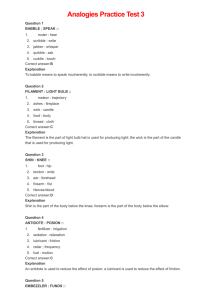
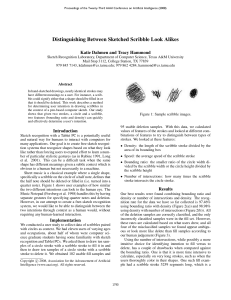

![iPads_and_Writing_2013[1]](http://s2.studylib.net/store/data/005383991_1-1bc8c0f2382c2ccb89e094c534f531f0-300x300.png)

